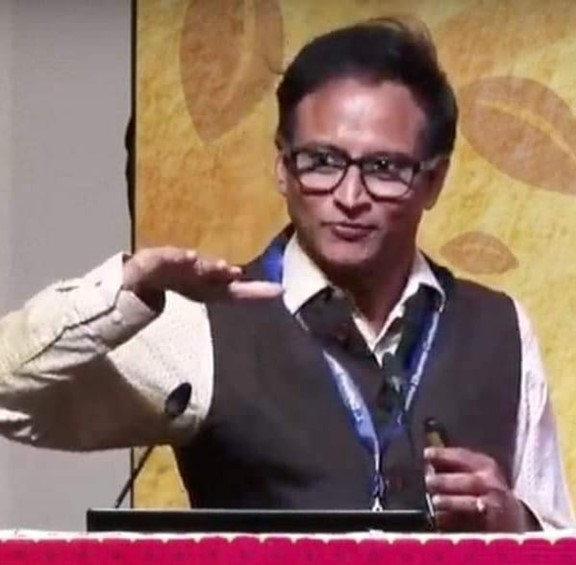
Jaina Convention
Federation of Jain Associations In North America
Jain "Dharma" Beyond Religion
What is Religion?
Pankaj Jain
Pankaj Jain is a software engineer who changed his professional interests to persue Master's degree Columbia University) and PhD (University of Iowa) in Indian religions. He is currently completing his dissertation, "Religion and Ecology of Rajasthan," while teaching Sanskrit In Rutgers University and World religions in New Jersey City University. Pankaj is a member of several Asian and Indic studies professional societies as well as a poet.Religion is derived from Latin word religio meaning reverence or conscientiousness. It also means Res (With regard to) + legere (to gather) and Re (again) + lego (read). Hence, etymologically "religion" is meant to gather a community to read the Holy Book and to have reverence for the Holy God. This unique focus on book and God makes a religion conclusive, exclusionary and Separative. In these three ways the Indic notion of Dharma is very different from the notion of Religion.
What is Dharma?
In Ahimsa Paramo Dharma, dharma means virtue. In Saman Suttam 3-5, Kevali pannattam dhammam saranam pavvajjami, dharma means the teachings of the Kevalins. In Sahu Dhamma, dharma means conduct and profession of monks. Dharma is derived from Sanskrit dhri meaning to sustain, support or hold. In Mahabharata, definition of dharma signifies the upholding of both this-worldly and the other-worldly affairs: Dhaaranaad dharma ity aahur dharmena vidhrtaah prajaah, Yat syaad dhaarana sanyuktam sa dharma iti nishchayah (Mahabharata 12.110.11). And in the Vedas, Prithivim Dharmanaa Dhritam, signifies dharma as sustainer. In Buddhism, Dharmam Sharanam Gachhaami meant that the teaching of Buddha. Thus, we see that dharma has multiple meanings in the Indian context, such as, conduct, cosmic law and virtue. Dharma clearly transcends the exclusionary definition of "religion".
Some Comparative Themes of Dharma and Religion
- Multiplicity of adherence of faiths
Surveys have indicated that more than 75% of Japanese consider themselves as both Shinto and Buddhists. A popular Japanese saying is "Born Shinto, Die Buddhist", meaning the life-cycle rituals of Japanese are inspired by Shintoism whereas the death rituals are inspired by Buddhism. Similarly, in China, a Chinese can visit a Buddhist temple, live life inspired by Taoist ideals, worship ancestors and at the same time philosophize based on Confucianism. The situation is similar in India. A Jain can visit Jain temple with the same devotion as one worships Laxmi and Ganesha, especially on the Diwali festival. Saraswati is another example of pan-Indian goddess of knowledge. Similarly, in Punjab, a Sikh can visit Gurudwara with the same fervor as he chants or writes Jai Mata Dee at the back of his truck. This simultaneous practice of several Asian traditions is possible because they are not "religions" in the Western sense
- Polycentrism
In India, there are 33 "koti" deities in Hinduism, 24 Tirthankaras in Jainism, 10 Gurus in Sikhism, thus the centers of one's prayer or ritual can be multiple instead of one figure. Similarly, In China there are hundreds of gods and saints. In Japan, there are infinite numbers of Kamis (gods). Again, this polycentric phenomenon is highly unlikely in the Western religions. - Transmigration
In India, all the philosophies consider the time and the universe to be of cyclical nature instead of linear as in Western religions. One can attain a better or worse next birth based on one's karma in the past birth. This notion again is a uniquely dharmic notion not found in Western sense of "religion". - No Sacred/Profane dichotomy
In the Western religions, "sacred" is seen as distinct from "mundane". But in Asian tradition, dharma pertains to everyday life in addition to visiting the sacred places. To follow Jainism for example, one's entire life needs to be changed including dietary habits. Thus, there is no separate category of "religion" as distinct from daily life. - No "Organized" religion
Western religions are organized around the Pope or the Sharia. However, in India, in every age new thinkers have challenged and reinterpreted the traditions in innovative ways thus no single tradition could emerge as one state religion. Similarly in China, Buddhism was rarely a state religion. In China, Shinto was a state religion only from 1 889 to 1 946. - "Mythistory", not history
Indian traditions trace their origins to prehistoric times. The historicity of the twenty four tirthankaras in Jainism or of Rama or Krishna in Hinduism is not as critical as the historic events in Western religions. Similarly in Japan, it is popularly believed that Izanagi and Izanami created Japan and other kamis. In China, the Taoist texts have no historic writer. However, in Western religions, the Exodus of Moses, the Crucifixion of Jesus Christ, the Hijra of Mohammad is centrally important. - Texts
In the Indian context, we have multiple Jain Aagamas and multiple Vedas, Upanishads, Puranas in Hinduism. In China, there are two Taoist and five Confucianist texts. In Japan again, there are more than one Shinto texts. In the Western context, one holy text such as Torah, Bible or Quran is central to the religion. - Religious Rivalry
In India, polemic debates among several philosophies of Hinduism, Buddhism and Jainism have rarely turned into violent wars and battles as is the case in the Western religions. Similarly in China, for the most periods, Buddhism co-existed harmoniously with Taoism and Confucianism. In Japan, as we saw above, Buddhism existed with Shintoism. However, the Western history has several incidences of Crusades, Jihads, and anti-Semitism.
From these above eight themes, we can now conclude that it may be preferable not to call any Asian tradition as religion. It may be better to situate Jainism also as a dharmic tradition instead of referring it as a religion.
 Professor Ph. D. Pankaj Jain
Professor Ph. D. Pankaj Jain
